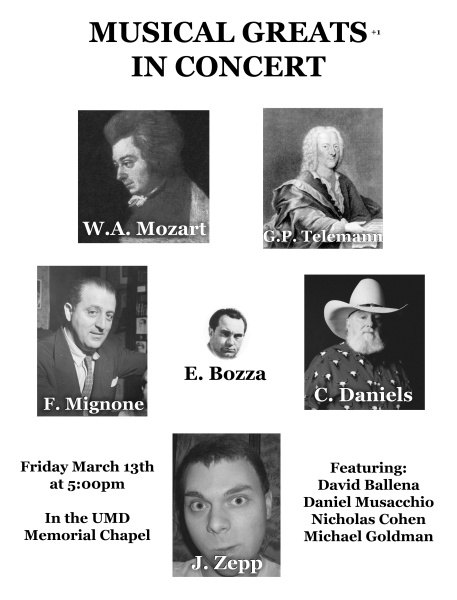-My Senior Recital

My last recital at the University of Maryland, this recital was performed on Friday March 13th, 2009, at 5pm. This full length recital featured a large variety in accompanied and unaccompanied music, as well as an arrangement for bassoon quartet. The recordings are complete with program notes this time around.
Eugene Bozza - Récit, Sicilienne et Rondo (1936)
A French composer born in the early 20th century, Eugene Bozza was a prize winning violinist, composer, and conductor, though he is best known outside of France for his wind instrument chamber and solo music. His music developed out of emerging styles early in the 20th century, influences from Debussy and late romantic music as well as more contemporary styles and jazz. This piece was composed as a new work for a competition at the Paris Conservatory and was Bozza's first work for solo bassoon and piano. Its three sections offer contrasting styles: a recitative style section of free solo playing with piano punctuation, a Sicilianna style dance section featuring dotted rhythms and lyrical lines, and a Rondo with some development on the end of the theme each time it returns.
Récit, Sicilienne et Rondo
Georg Philipp Telemann - Fantasia #9 in F Major (1732)
This piece was originally a work for transverse flute, number 4 in Bb major, but was transposed and reprinted for bassoon in a different order by Harold Wevers. This work comes from the set of 12 Fantasias Without Bass published by the composer for solo performance. These pieces were meant for amateurs and connoisseurs alike, in that they are easy enough for an amateur flute player to enjoy, but intricate enough for a virtuoso player. These pieces represent a style of idiomatic solo wind instrument music which was unusual for its time, and each fantasia was composed in a unique way, no two of them mimic each other or even share a structure of movements. Fantasia number 9 begins with a slow and sweet Andante with meandering harmonies and a distinctive combination of large leaps and dotted rhythms. The second movement is a bright and playful Allegro, with very clear harmonies and sections imitating counterpoint between two instruments. The final Presto movement is a triumphant and somewhat schizophrenic romp in a straight forward AABA form.
Fantasia #9 in F Major
Francisco Mignone - Concertino for Bassoon (1957)
Francisco Mignone is a Brazilian composer who lived and studied music for most of the 20th century and is considered in league with Heitor Villa-Lobos. Because Italians comprised most of the music teachers in Brazil at that time, he was trained in a system with deep European roots and this influenced his music heavily. The two movement "Concertino para fagote e pequena orquestra" was written in 1957 for Brazillian bassoonist Nöel Devos with small orchestra accompaniment. The first movement is a modinha seresteira, a slow sentimental song characterized by large leaps, rhythmic variety, ornamented vocal lines, and a minor tonality. The second movement is in the character of choro music, a kind of popular improvised dance music over simpler harmonies, imitating the style of the ensemble choro ensemble and musical genre together.
Concertino for Bassoon
Wolfgang Amadeus Mozart - Concerto in Bb KV.191 (1774)
The Concerto for Bassoon KV.191(K.186e) by W. A. Mozart is considered a staple in bassoon literature and is one of only a handful of bassoon concerti by the most well known composers. It is thought to be composed for the amateur bassoonist Franz Thaddäus von Dürnitz, but much of the history surrounding the piece, including the original manuscript, have been lost. It is known, however, that at least three other bassoon concerti were written, along with a sonata, though none of them exist. This concerto was originally written with only a small orchestra accompaniment of 2 oboes, 2 French horns, 2 violin parts, a viola, and a cello. The first movement is a lively Allegro where the bassoon acts as both a soloist and a counterpart to the orchestra. The second is slow and lyrical with an astonishingly short development section, only four measures long. The final Rondo gives the orchestra the spirited theme most often and the bassoon the episodic content. The movement finishes with the theme appearing in the solo voice for the first time and a characteristic ending section restating previous ideas.
Concerto in Bb KV.191
Charlie Daniels, Arranged by Jonathan Zepp - The Devil Went Down to Maryland (2009)
I arranged this piece from Charlie Daniels' "The Devil Went Down to Georgia," which incorporates rock, country fiddle, and spoken word influences into a piece which reached number three on the top 100 charts. The lyrics and title have been changed to reflect it being arranged for four bassoons and happening in Maryland, but they stay true to the original whenever possible. The piece tells the story of the Devil's mischief backfiring after challenging Jonny to a bassoon play-off (the original story involves a fiddle competition instead, and an "h" in Jonny), wagering the ultimate instrumental prize against Jonny's soul. The original story begins with the Devil searching for souls to steal, when he comes across Johnny playing tunes on his fiddle. The wagers are placed and the somewhat reluctant Johnny accepts in his challenge (in the song version, Johnny is much more confident in accepting the challenge.) The Devil then begins with his band of demons, playing a fiery solo which makes the weather stormy and hail fall from the sky. Johnny remains confident and plays his own solo in response including many folk melodies, which are the seemingly random lyrics sung on both sides of the solo. In the bassoon quartet version the Devil interrupts and the dueling begins, each player trying to one-up each other. Johnny eventually beats the Devil who concedes the prize, but is so charmed by Johnny's playing that he asks to hear the theme one last time.
The Devil Went Down to Maryland
3/16/09

